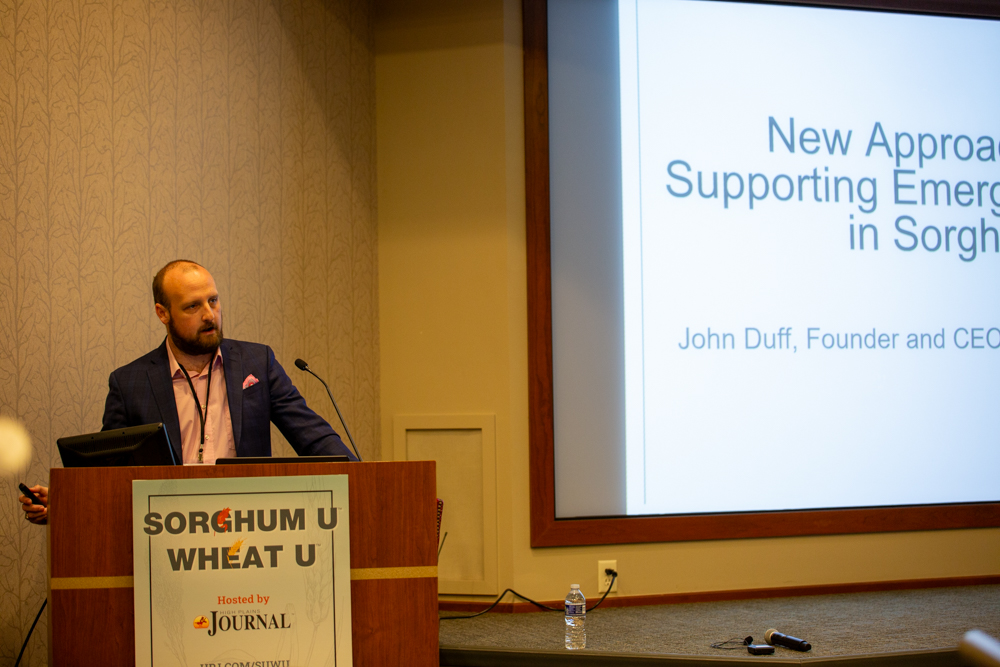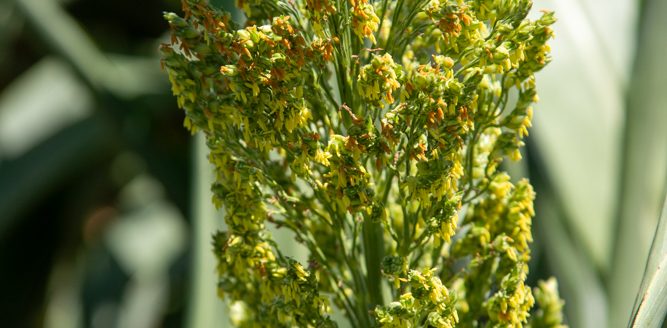Duff discusses new approaches to support emerging markets in sorghum at SUWU

Marketing a crop used to be as simple as hauling a truckload to the local grain elevator. Times have changed and opportunities have too.
John Duff, former executive vice president for the National Sorghum Producers, now manages a boutique consultancy that specializes in sustainability and economic strategy. Duff spoke this summer at the Sorghum U/Wheat U event in Wichita, Kansas, and discussed supporting emerging markets.
He started Sero Ag Strategies a few years ago to bridge the gap between innovative ag ideas and emerging market opportunities. His focus is on sustainability, but he also focuses on general market development and emerging market support and investments.
“Sero comes from a Latin verb meaning to produce, to bring forth or propagate and that name and what it stands for means a lot, but that’s really what I’m trying to do every day. I try to produce, bring forth and propagate opportunities for farmers,” Duff said.
Sorghum is an extremely important crop globally, being one of the top five cereal crops with about 100 million acres worldwide.
Most countries don’t have near the acres of the United States, but it’s still important to recognize the biggest competitor—Sudan and Nigeria.
“We’re talking about acre fields and harvest by machete,” he said. “They save heads to plant next year, and it’s just a completely different scale in agriculture.”
Market opportunities are starting to reflect those stark differences, according to Duff. The other big driver for sorghum markets is water.
“Water is a real passion of mine, and it’s for good reason. It’s a real issue,” he said.
Sorghum uses less water and is an important crop in those areas where drought and low rainfall are prevalent.
“I think that increasingly we’re seeing, and we’re going to see, market opportunities that reflect that,” he said. “We’re seeing rising demand for sorghum as a food crop in Africa and Asia Pacific region, and a lot of that is driven by many of the same kind of consumer factors that you see here in the U.S.”
Consumers want non-GMO grains, Duff said, plus there is sorghum in the pet food sector. Demand continues to grow for industrial uses like biofuels and sustainability opportunities.
“There’s inset markets, like companies that are looking at their own supply chains and trying to figure out how to do better within their own supply chains, and so they’re using sorghum as a way to do better,” Duff said. “But also in current markets, whether that’s for biofuels or whether that’s other ancillary carbon markets, outside of the biofuel space, there’s growing opportunities for those in the marketplace.”
Investments in sorghum are typically thought of at the checkoff level.
“When we talk about investment we’re talking more about sort of one-way seed money,” he said. “Money that just goes in the generic promotion. Maybe it goes to a company from time to time, but it just promotes sorghum generically.”
That system has produced results, but the sorghum industry has chosen to take a more active role in investment opportunities and trying to drive such opportunities. Different levels of investing include angel investing, private equity investing or venture capital models.
Duff said the sorghum industry has focused on something that looks more like angel investing space for startups. Ag tech is “massive right now” according to Duff and valued at $23 billion. And of course, sustainability is a big part of that market.
“Any technologies that can promote sustainability, promote climate resilience, lower an environmental footprint are going to get a big look from private equity, from angels, from venture capitalists to all the investing spaces is really focused heavily on sustainability and driving down the carbon footprint,” Duff said.
So, what has the sorghum industry done? The industry has introduced cSMART or Collaborative Sorghum Marketing Transformation Program and Duff said this model is being “pioneered as we speak by the sorghum industry.”
“It’s dedicated to promoting sorghum marketing and R and D expenditures that match private angel investments,” he said. “We’re led by a board of five that’s got farmers on it, it’s got end users on it. It’s got supply. It’s got ag input suppliers on it. And all of those board members have multiple hats.”
Duff said it came together in a thoughtful way to represent all those different sectors because the entire supply chain can create an opportunity to help support startup. It matches private investments one to one with cash injections. Typically, they range from $40,000 to $300,000.
The goal of a program is to raise equity and put it back into the industry. Three projects have been supported in the last year—two sorghum food startups and one container business that facilitates exports of sorghum in containers.
“Everybody loves it because the investor isn’t diluting,” he said. “If I go to a potential investor, when I say, the sorghum industry believes in this startup so much that the sorghum industry is willing to put its own cash on the line, it makes it a whole lot easier for an investor to say, I’ll throw $5,000 toward that project.”
For more information about cSMART visit www.csmartsorghum.com/.
Kylene Scott can be reached at 620-227-1804 or [email protected].




